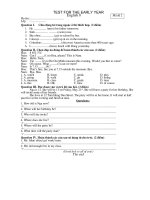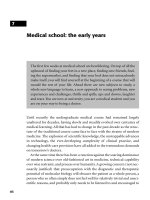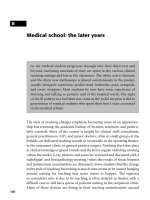Medical school - the early years 1
Bạn đang xem bản rút gọn của tài liệu. Xem và tải ngay bản đầy đủ của tài liệu tại đây (569.3 KB, 18 trang )
Until recently the undergraduate medical course had remained largely
unaltered for decades, having slowly and steadily evolved over centuries of
medical learning. All that has had to change in the past decade as the struc-
ture of the traditional course came face to face with the strains of modern
medicine. The explosion of scientific knowledge, the unstoppable advances
in technology, the ever-developing complexity of clinical practice, and
changing health-care provision have all added to the tremendous demands
on tomorrow’s doctors.
At the same time there has been a reaction against the soaring dominance
of modern science over old-fashioned art in medicine, technical capability
over wise restraint, and process over humanity. A growing concern (not nec-
essarily justified) that preoccupation with the diagnostic and therapeutic
potential of molecular biology will obscure the patient as a whole person, a
person who so often simply does not feel well for relatively trivial and unsci-
entific reasons, and probably only needs to be listened to and encouraged to
7
Medical school: the early years
83
The first few weeks at medical school are bewildering. On top of all the
upheaval of finding your feet in a new place, finding new friends, find-
ing the supermarket, and finding that your bed does not miraculously
make itself, you will find yourself at the beginning of a course that will
mould the rest of your life. Ahead there are new subjects to study, a
whole new language to learn, a new approach to seeing problems, new
experiences and challenges, thrills and spills, ups and downs, laughter
and tears. You are now at university, you are a medical student and you
are on your way to being a doctor.
take responsibility for his or her own health. A fear that health-care teams
under pressure from every direction may give the impression that they have
forgotten how to care in the fullest sense – and, worse still, may indeed lose
sight of the humanity of medicine.
The Prince of Wales put his finger on the issue in a “Personal View” in the
British Medical Journal, writing “Many patients feel rushed and confused at
seeing a different doctor each time … and many health-care professionals
feel frustrated and dissatisfied at being unable to deliver the quality of care
they would like in today’s overstretched service”.
There has also been a reaction against the traditionally closed mind of the
medical profession towards complementary and alternative medicine, partly
because of dissatisfaction with the fragmentation of conventional medicine
and partly because of the effects of relentless pressure on doctors. As some
patients derive benefit from unorthodox medicine (often when traditional
medicine has failed) – however obscure the mechanism of the benefit may
be – doctors need to be informed about such therapies and the evidence,
such as it is, for their effectiveness. As the Prince of Wales observed in his
“Personal View”: “It would be a tragic loss if traditional human caring had
to move to complementary medicine, leaving orthodox medicine with just
84 Learning medicine
the technical management of disease”. At the end of the day, it may well be
that the greatest benefit of complementary therapies derives from the ther-
apist being able to give more time to listening to the patient. Be that as it
may, it is clearly in the patient’s interest to “create a more inclusive system
that incorporates the best and most effective of both complementary and
orthodox medicine … choice where appropriate, and the best of both
worlds whenever it is possible”.
Recommendations published by the General Medical Council (GMC) in
2002 provided a new impetus to the introduction of a new medical curricu-
lum. Less emphasis was put on absorbing facts like a sponge and more on
thinking: on listening, analysing, questioning, problemsolving, explaining,
and involving the patient in his or her own care; more emphasis on the
patient as a whole in his or her human setting. The biological and behav-
ioural basis of medicine in most medical schools now focuses on “need to
know and understand”. Oxford and Cambridge remain perfectly reasonable
exceptions, having retained a strongly and intrinsically medical science cen-
tred curriculum in the first 3 years. The GMC encourages diversity within
the curriculum and students should carefully consider which sort of cur-
riculum would best inspire their mind, heart, and enthusiasm.
You can usually get a flavour of how the course is delivered at each school
by reading the curriculum and students’ views section on the medical
schools’ web sites (see Appendix 5) or in their prospectuses.
Nevertheless, at most universities the traditionally separate scientific and
clinical aspects of the course have become very substantially integrated to
prevent excited and enthusiastic students becoming disillusioned in the first
2 years with what understandably seemed to be divorced from real patients
and real lives, from clinical relevance and clinical understanding.
The most recent development in undergraduate medical education has
been that of the Medical School Charter from the Council of Heads of
Medical Schools and BMA medical students (see Appendix 1). Launched in
2006 this document enlists the rights and responsibilities of medical stu-
dents in part one and medical schools in part two and represents a ‘contract’
that students sign on enrolling at medical school. To date, it has been
adopted by University of East Anglia, Leicester, Southampton, Aberdeen and
Cardiff, with more medical schools expected to join in the future. The char-
ter will be reviewed every 2 years.
85 Medical school: the early years
The subjects, systems and topics
Most first-year students begin with a foundation course covering the fun-
damental principles of the basic medical sciences. These include anatomy –
the structure of the human body, including cell and tissue biology and
embryology, the process of development; physiology – the normal func-
tions of the body; biochemistry – the chemistry of body processes, with
increasing amounts of molecular biology and genetics; pharmacology – the
properties and metabolism of drugs within the body; psychology and soci-
ology – the basis of human behaviour and the placing of health and illness
in a wider context; and basic pathology – the general principles underlying
the process of disease.
As the general understanding of the basics increases, the focus of the
teaching often then moves from parallel courses in each individual subject
to integrated interdepartmental teaching based on body systems – such as
the respiratory system, the cardiovascular system, or the locomotor system –
and into topics such as development and aging, infection and immunity,
and public health and epidemiology.
In the systems approach the anatomy, physiology, and biochemistry of a
system can be looked at simultaneously, building up knowledge of the body
in a steady logical way. As time and knowledge progress the pathology and
pharmacology of the system can be studied, and the psychological and soci-
ological aspects of related illnesses are considered.
Often the normal structure and function can best be understood by
illustrating how it can go wrong in disease, and so clinicians are increas-
ingly involved at an early stage; this has an added advantage of placing the
science into a patient-focused context, making the subject more relevant
and stimulating for would-be doctors. It also allows for early contact with
patients to take place in the form of clinical demonstrations or, for exam-
ple, in a project looking at chronic disease in a general practice population
or on a hospital ward.
In some medical schools, such as Manchester and Liverpool, practically
all the learning in the early years is built around clinical problems that focus
all the different dimensions of knowledge needed to understand the illness,
the patient, and the management.
86 Learning medicine
The teaching and the teachers
The teaching of these subjects usually takes the form of lectures, laboratory
practicals, demonstrations, films, tutorials and projects, and, increasingly,
computer-assisted interactive learning programmes; even virtual reality is
beginning to find its uses in teaching medical students.
The teaching of anatomy in particular has undergone great change.
Dissection of dead bodies (cadavers) has been replaced in most schools by
increased use of closed circuit television and demonstrations of prosected
specimens and an ever-improving range of synthetic models. Preserved
cadavers make for difficult dissection, especially in inexperienced if enthusi-
astic hands, and, although many regarded the dissecting room as an impor-
tant initiation for the young medical student, fortunately much of the detail
needed for surgical practice is revised and extended later by observing and
assisting at operations and during postgraduate training. Much more useful
to general clinical practice is the increased teaching of living and radiologi-
cal anatomy. In living anatomy, which is vital before trying to learn how to
87 Medical school: the early years
examine a patient, the surface markings of internal structures are learnt by
using each other as models. This makes for a fun change from a stuffy lec-
ture theatre as willing volunteers (and there are always one or two in every
year) strip off to their smalls while some blushing colleague draws out the
position of their liver and spleen with a felt tip marker pen.
Similarly, with the technological advances in imaging parts of the body
with X-rays, ultrasound, computed tomography, magnetic resonance imag-
ing, radionucleotide scans, and the like, and their subsequent use in both
diagnosis and treatment, the need to have a basic understanding of anatomy
through radiology has never been greater.
Practical sessions in other subjects, especially physiology and pharmacol-
ogy, often involve students performing simple tests on each other under
supervision. Memorable afternoons are recalled in the lab being tipped
upside down on a special revolving table while someone checked my blood
pressure or peddling on an exercise bike at 20 kilometre per hour for half an
hour with a long air pipe in my mouth and a clip on my nose while my vital
signs were recorded by highly entertained friends or recording the effect on
the colour of my urine of eating three whole beetroots, feeling relieved not
to be the one who had to test the effects of 20 fish oil capsules. As well as the
performing of the experiments, the collation and analysis of the data and the
researching and writing up of conclusions is seen as central to the exercise,
and so students may find themselves being introduced to teaching in infor-
mation technology, effective use of a library, statistics, critical reading of
academic papers, and data handling and presentation skills.
The teaching of much of the early parts of the course is carried out by
basic medical scientists, most of whom are not medically qualified but who
are specialist researchers in their subject. Few have formal training in teach-
ing but despite this the quality of the teaching is generally good and the
widespread introduction of student evaluation of their teachers is pushing
up standards even further. Small group tutorials play an important part in
supplementing the more formal lectures, particularly when learning is cen-
tred around a problemsolving approach, with students working through
clinical-based problems to aid the understanding of the system or topic
being studied at that time. The tutorial system is also an important anchor
point for students who find the self-discipline of much of the learning
harder than the spoon-feeding they may have become used to at school.
88 Learning medicine
Students may also have an academic tutor or director of studies or a
personal tutor, or both, a member of staff who can act as a friend and
adviser. The success or failure of such a system depends on the individuals
concerned, and many students prefer to obtain personal advice from sym-
pathetic staff members they encounter in their day-to-day course rather
than seeking out a contrived adviser with whom they have little or no natu-
ral contact. In some schools, most notably in Oxbridge, the college-based
tutor system is much more established and generally plays a more important
personal and academic part.
Links are sometimes also set up between new students and those in older
years; these “link friends”, “mentors”, or “parents” can often be extremely
useful sources of information on a whole range of issues from which text-
books to buy to which local general practitioner to register with and useful
tips on how to study for examinations, and of course numerous suggestions
on how to spend what little spare time you can scrape together.
In every school there will be a senior member of staff, a sub-dean or
director of medical education, who oversees the whole academic pro-
gramme and can follow the progress of individuals and offer a guiding
hand where needed.
As students progress other topics are added into the course. Most schools
provide first-aid training for their students, and a choice of special study
modules (SSMs) are offered each year to encourage students to spend some
time studying in breadth or depth an area which interests them and in which
they can develop more knowledge and understanding. Early patient contact
is encouraged; sometimes through schemes which link a junior student with
a ward where small group teaching takes place or through projects or simply
by gaining experience of the work of other staff, such as nurses, health visi-
tors, physiotherapists, and occupational therapists; or time can be spent just
talking to patients and relatives. Some schools begin a module in the first
year which introduces aspects of clinical training, ideally in the setting of
general practice, with the same doctor every week or two for 1 or 2 years.
The supervised learning includes skills such as history taking and clinical
examination or the interpretation of results of clinical investigations.
In the early part of some courses students may be introduced to a local
family with whom they will remain in contact for the duration of their time
as a student. Such attachment schemes, which are often organised by general
89 Medical school: the early years









